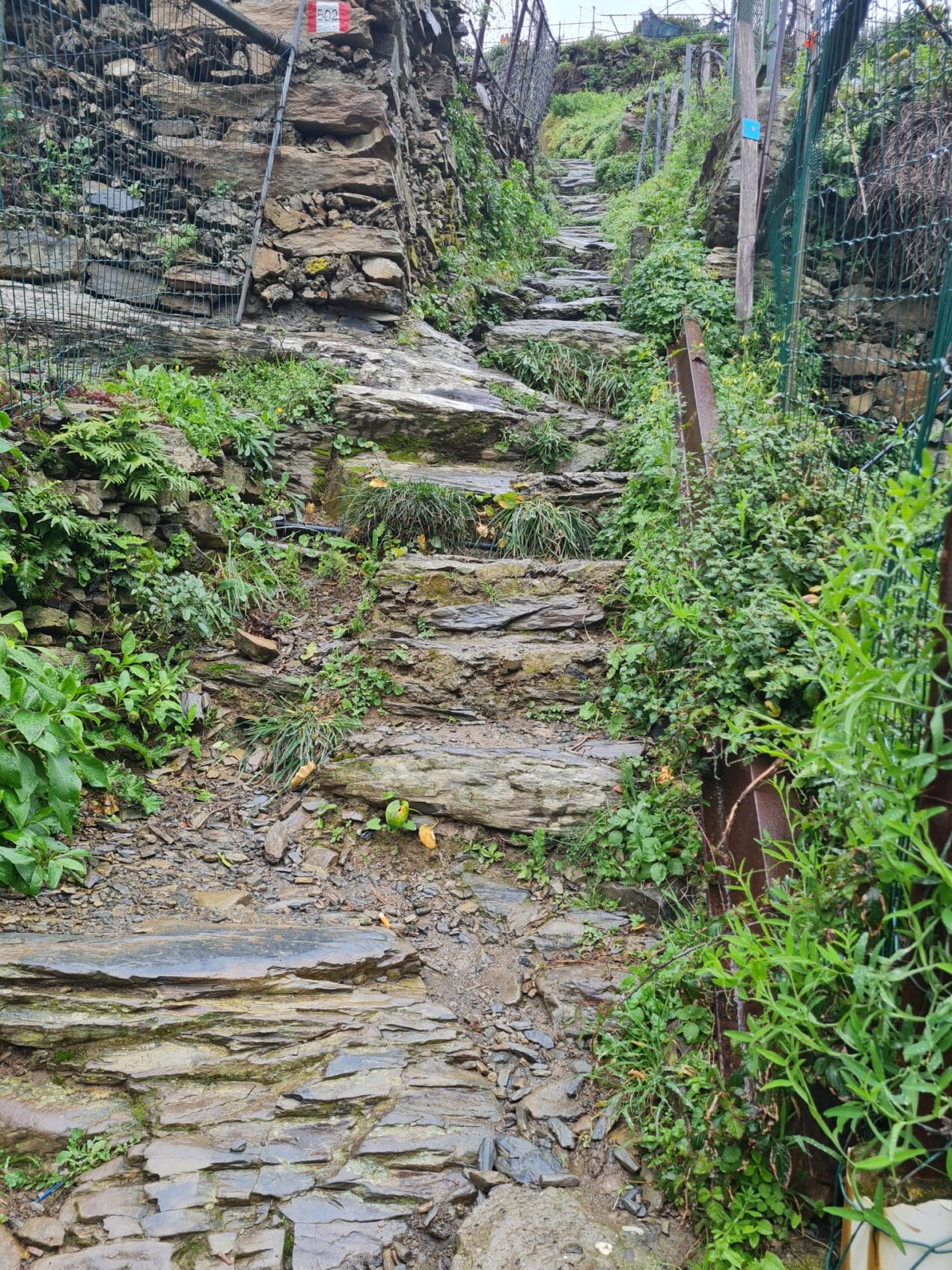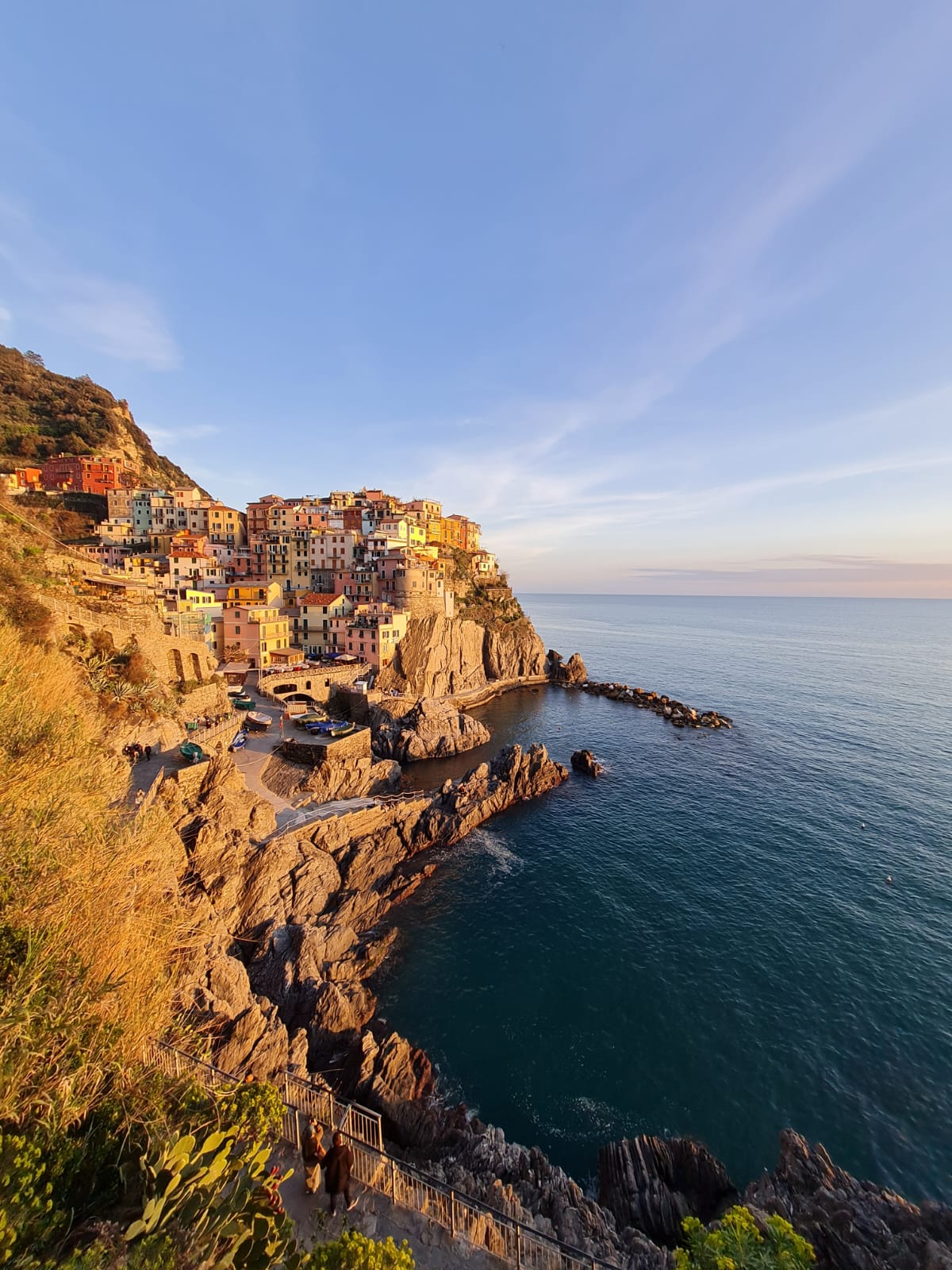The Cinque Terre consists of five charming towns that seem to cling to the rocky cliffs along a short stretch of the Ligurian coastline in northern Italy. These towns are renowned for their historic mule paths, which connect them and draw thousands of hikers each year.
While the scenery is breathtaking, the area is also quite delicate. Overtourism has severely impacted both the villages and the surrounding landscape. Nonetheless, you should definitely consider visiting; just keep a few important points in mind:
Access to the famous Sentiero Azzurro (Blue Trail) along the coastline between the five Cinque Terre towns is no longer available.
When I guided in this region about 20 years ago, we would stay in the nearby town of Sestri Levante. Each morning, we would take the train to Monterosso al Mare—the northernmost of the five towns—arriving around 9:30 am. From there, we would hike the Sentiero Azzurro, traveling from Monterosso to Vernazza, then Corniglia, Manarola, and finally Riomaggiore in a single day. The trail used to run right along the water, making the hike mostly flat (with the exception of the climb to high-altitude Corniglia).
Today, however, much of this trail is closed. You can still hike from Monterosso to Vernazza and from Vernazza to Corniglia, but the section between Corniglia and Manarola has been closed indefinitely, and the popular Via d’Amore stretch connecting Manarola to Riomaggiore has been shut since 2012. While there are plans for it to reopen in the summer of 2024, no specific date has been announced yet.
There are alternative trails that offer equally stunning views, but be prepared for challenging hikes that require suitable footwear and a moderate to high fitness level.
Three networks of trails run parallel to the coast in Cinque Terre. The first is the Sentiero Azzurro, the most well-known option, but it is only partially accessible. Even the open sections can close suddenly due to landslides and are typically closed during the winter for maintenance.
About halfway up the hillside, the Path of the Sanctuaries offers a panoramic alternative, though it requires a significantly more strenuous effort. This trail connects several historic sanctuaries perched high in the hills, providing views of the coastline from above. There are secondary trails that lead down to each town, making it a great option for avid hikers to traverse from one town to another. Be sure to wear sturdy hiking shoes, a sun hat, and carry plenty of water.
At the top of the hill lies the Alta Via (or High Path), a high-altitude route that hugs the ridge running behind the Cinque Terre villages and stretches from Levanto to Portovenere. This demanding trail is best suited for experienced hikers whose main focus is on hiking rather than sightseeing in the towns of Cinque Terre.
The hiking trails (as well as the trains and towns) in Cinque Terre are often crowded.
The Sentiero Azzurro used to be a pleasant hike, where one could meet fellow hikers while still enjoying some moments of solitude. However, the situation has changed: the remaining sections can become extremely crowded during peak season, leading the park to enforce a one-way hiking rule from Monterosso to Vernazza to alleviate congestion.
Be prepared for crowds on the trains that connect the towns as well. Trains run often, but demand sometimes exceeds supply, resulting in cramped conditions while traveling from one town to the next, especially on weekends and holidays. It’s advisable to purchase a Cinque Terre Card, which includes unlimited train rides, allowing you to skip the ticket machines and board whichever train you prefer.
Additionally, the five Cinque Terre towns get overcrowded in the summer months. Most villages—except for Monterosso—are small hamlets with a main street and a couple of narrow pedestrian alleys. Most visitors tend to stick to the main road and waterfront areas, creating congestion in these parts of the towns during high season.

While the Cinque Terre can be busy, there are ways to escape the crowds.
Exploring the Cinque Terre independently might leave you feeling underwhelmed, given the crowds, complicated logistics, and the challenge of grasping the historical significance of this UNESCO World Heritage Site. However, you can avoid the throngs and truly appreciate the area’s history and beauty by embarking on guided “urban trekking” itineraries.
These itineraries typically begin in one of the five towns—like Manarola—where the guide can explain how each farming village has evolved (not just fishing, as some might think). You’ll then walk out of town along a brief, manageable trail for about an hour to witness the terraced hills and enjoy breathtaking coastal views. Afterward, you can board the train to explore another town in the same way, repeating the process. You can visit all five towns this way or focus on two or three by land and finish your day with a boat tour to admire the remaining towns and coastline from the sea.
If you choose to hike independently, remember that the Cinque Terre trails frequently close.
Due to the instability of the cliffs, landslides are common in this picturesque area. Past significant landslides have caused considerable damage to towns like Monterosso and Vernazza, particularly in 2012. Even minor floods or landslides necessitate trail repairs or closures for safety reasons. Before your hike, always check the status of the trails. Trails that are marked in black are closed, while those in blue, green, and red are open and categorized by their difficulty level. Additionally, trails may close during heavy rain or storms; if an orange or red weather warning is issued, boats will return to shore and trails will be closed until the warning is lifted.
A Cinque Terre Card is required to access the trails.
As a national park, you need a Cinque Terre Card to access various services, including trails, trains, buses, public restrooms, and Wi-Fi. If you are not hiking, a Cinque Terre Card is not necessary, but it’s worth considering since it provides unlimited train rides, allowing you to avoid long lines at ticket machines. Note that passes do not include boat fares—whether for ferries or boat tours—but taking a ride between at least two towns for a seaside view of the coastline is highly recommended.

A day trip from Florence to the Cinque Terre is not advisable.
I frequently receive inquiries about visiting the Cinque Terre as a day trip from Florence. If you feel you must do so, be prepared for a long day; it’s about 2.5 to 3 hours each way by train, depending on your connection. Arriving by train? Absolutely. Traveling from Florence? Sure. However, as a day trip? It’s not ideal. I recommend finding accommodations closer by—either within one of the five towns or in attractive coastal towns like Sestri Levante, Santa Margherita Ligure, or Camogli, all of which are less than an hour away by train.
Here are a couple of unique suggestions for exploring the Cinque Terre.
Did you know that there is a hidden nude beach? It’s a secret, so shh!
Lastly, if you are interested in local culture and sustainable tourism, I recommend the film Vendemmia. This movie focuses on the local wine, Schiaccetra’, while also highlighting the efforts of the locals to maintain their ancestral traditions in the face of mass tourism and its effects on local politics. Vendemmia poses the crucial question: is it possible to preserve the future without sacrificing the past?



